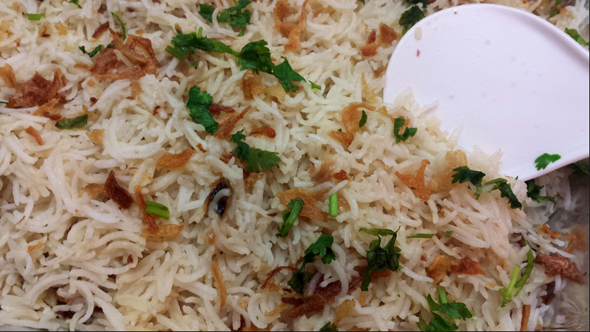Mama’s Punjabi Recipes: Bhune Pyaaz ka Pulao (Brown Onion Pilaf)
This pulao recipe is tasty and unique because the cooked rice comes out looking brown, though it is not made with brown rice. The rice still has the distinct taste and aroma of regular basmati rice and because of the way it is made, the pulao has the additional taste of spiced onions. It is a very Punjabi dish made on parties and other special occasions.
Chawal (rice) is a basic ingredient that accompanies many Indian cuisines, irrespective of the part of the country, but for special occasions like weddings, it is usually prepared as a pulao (pilaf), which can include vegetables or various meats and can even include nuts and raisins; saffron and black cloves, depending on the rest of the dishes you wish to complement.
Pulao is a method of cooking adopted from the Persians in which rice is cooked in a seasoned broth with meat or vegetables. A variation of it can be found in the Middle East, Central and South Asia, East Africa, Latin America and the Caribbean.
In this recipe, the rice will become brown because of the color of the browned onions and a mix of spices. This is why I call this “brown onion rice” when served with garam masala. There is no need to add haldi (turmeric) or mirch (pepper) to the rice.
Ingredients:
2 cups chawal (rice) – preferably white Basmati
2 medium pyaaz (onion)
4 cups pani (water)
2 tbsp olive oil or any other oil you prefer
2 kali illachi (large black cardamom)
4 loung (cloves)
2 daal chinni (cinnamon sticks) – break into large pieces
1 teaspoon garam masala (black pepper mix)
Namak (salt) to taste
Directions:
1. Wash the rice thoroughly in cold water and then let it soak for 30 minutes.
2. Peel the onion and cut into thin, long slices.
3. Pour the oil in a medium sized pot over medium heat. Throw in the sliced onion and stir till they are dark brown.
4. Add the water and then the salt, cloves, cardamom, cinnamon and garam masala. Stir and bring to a boil.
5. Drain the soaking rice, then add to the pot and bring to a boil again. Now cover the pot and reduce the heat to very low for 10 minutes.
6. When the rice fills the pot, check with a fork that there is no more water on the bottom and the rice is tender.
7. Turn the heat off; cover the rice with a clean piece of cloth and then place the cover back on so that condensation will not wet the rice. Leave the pot covered for 10 minutes.
8. Serve warm with plain yogurt, daal or rajmah (red beans) or eat simply with Indian pickles.
MAMA’S TIP OF THE WEEK
SIMPLE WAY TO MAKE TENDER BASMATI RICE
The way many people cook rice, it comes out sticky and clumps together, even if it is Basmati. This type of sticky rice is hard to serve as it sticks to the spatula and is also harder to eat. Sometimes the rice is overcooked so that the grains are broken and become mushy. This is especially true when using processed rice and is a common mistake that many new and inexperienced cooks make.
The secret to making rice that is not sticky and the grain separate easily is the amount of water used. Always use a ratio of 2 cups of water for 1 cup of white Basmati rice. If you use brown rice, then use 3 cups of water for each cup of rice. Usually, after the first boil, you should cook it under medium low heat for 10 to 15 minutes.

Shakuntla Malhotra is a skilled cook of Punjabi dishes made in the old-fashioned style that she learnt as a young woman in her ancestral home in Lyallpur (since renamed Faisalabad), India before it became part of Pakistan after the Partition in 1947. People have often admired her cooking for its simplicity and taste that comes with each mouthful. Even in her mid-eighties, she continues to cook daily and agreed to share some of her delectable Punjabi recipes.

